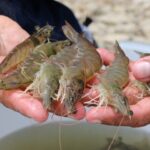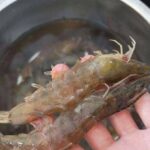Shrimp is a delicious and nutritious seafood delicacy that can be prepared in a myriad of mouth-watering dishes. But how do you ensure you’re getting the freshest shrimp for your culinary creations? One tell-tale sign is in the shape of its body.
1. Curved or Straight Shrimp: What Does Their Posture Reveal?
-
Fresh, live shrimp tend to have a gentle natural curve to their bodies. This curvature helps them propel themselves through the water with ease. However, when they are caught and die, their muscles contract, accentuating this curvature.
-
Straight, rigid shrimp, on the other hand, may be a sign of stale or chemically treated shrimp. These shrimp have either been dead for a while or have been treated with chemicals to maintain their appearance, hence the loss of their natural curvature.

2. Other Tell-Tale Signs of Fresh Shrimp
While body curvature is a good indicator, there are other factors to consider when selecting the best shrimp:
– Head:
-
Fresh shrimp: The head is firmly attached to the body and doesn’t come off easily.
-
Less fresh shrimp: The head may be loose or already detached, and the texture is soft and mushy.
– Shell:
-
Fresh shrimp: The shell is shiny and bright, free of any slimy substance.
-
Stale shrimp: The shell appears dull and may have a slimy coating or an unpleasant odor.
– Body:
-
Fresh shrimp: The body is firm and bounces back when gently pressed.
-
Less fresh shrimp: The body feels soft and mushy, and the flesh may even fall apart when handled.
– Eyes:
-
Fresh shrimp: The eyes are clear and shiny black.
-
Stale shrimp: The eyes are cloudy or may even fall out.
– Aroma:
-
Fresh shrimp: They have a mild natural briny odor.
-
Stale shrimp: They emit a strong putrid or sour smell.
3. Why is Fresh Shrimp Better for Your Health?
Fresh shrimp is packed with essential nutrients, including high-quality protein, heart-healthy omega-3 fatty acids, immune-boosting vitamin B12, iron, and zinc. They also provide calcium and phosphorus for strong bones. But when shrimp is not fresh, you not only lose out on these nutrients but also risk food poisoning from bacteria that thrive in stale seafood.

4. Additional Tips for Buying and Storing Shrimp
-
Opt for live shrimp if possible. They should be swimming or show signs of movement when touched.
-
If buying frozen shrimp, choose those that are still in their shells with clear, white flesh, free from any dark spots.
-
For storage, it’s best to freeze shrimp immediately if you’re not going to cook them right away. When thawing, avoid soaking them in water for too long, as this can affect their sweetness.
So, which is the better choice, curved or straight shrimp?
The answer is clear: opt for naturally curved shrimp with a gentle bend, coupled with other indicators of freshness, such as a bright shell, firm head, and bouncy flesh. Straight or abnormally curved shrimp should be approached with caution, as they may be of inferior quality or chemically treated.
When making your selection, consider multiple indicators to ensure you’re getting the freshest, most nutritious, and safest shrimp for your family’s dining pleasure.
Is Fanned or Curled Shrimp Tail Better? 5 Pro Tips for Choosing the Best Shrimp and Avoiding Chemical-Injected Ones.
When it comes to choosing the best shrimp, you’ll find a variety of options at the market – some curved, some straight, some with curled tails, and some with flared tails. But which one should you go for? This guide will help you navigate through the options and steer clear of shrimp that has been injected with foreign substances or is past its prime.
Choosing Shrimp: Curved or Straight? A Guide to Making the Right Selection.
Selecting the perfect shrimp can be a tricky business. Most people assume that the shrimp’s shape is a defining factor in determining its quality and freshness. But is it really that simple? Let’s dive into the intricacies of choosing between straight and curved shrimp to uncover the secrets of selecting the finest seafood.
How to Tell the Difference Between Farmed and Wild Shrimp: The Super Simple Trick Sellers Don’t Want You to Know.
Introducing the ultimate guide to mastering the art of shrimp differentiation. With years of experience in the seafood industry, our expert is here to reveal the secrets to telling farmed and wild-caught shrimp apart. Learn the tricks of the trade and impress your guests with your shrimp-savvy skills at your next dinner party. It’s time to elevate your seafood game!



































